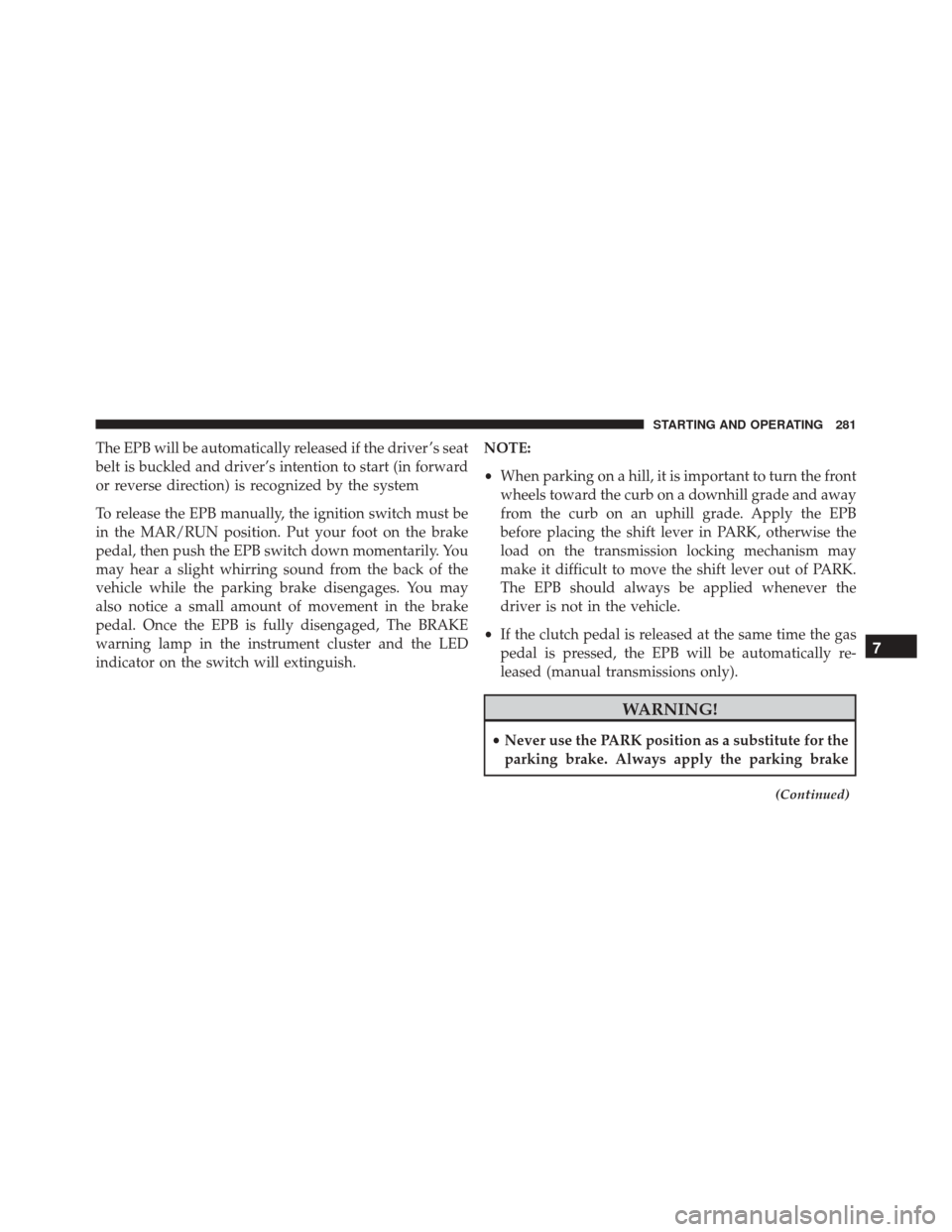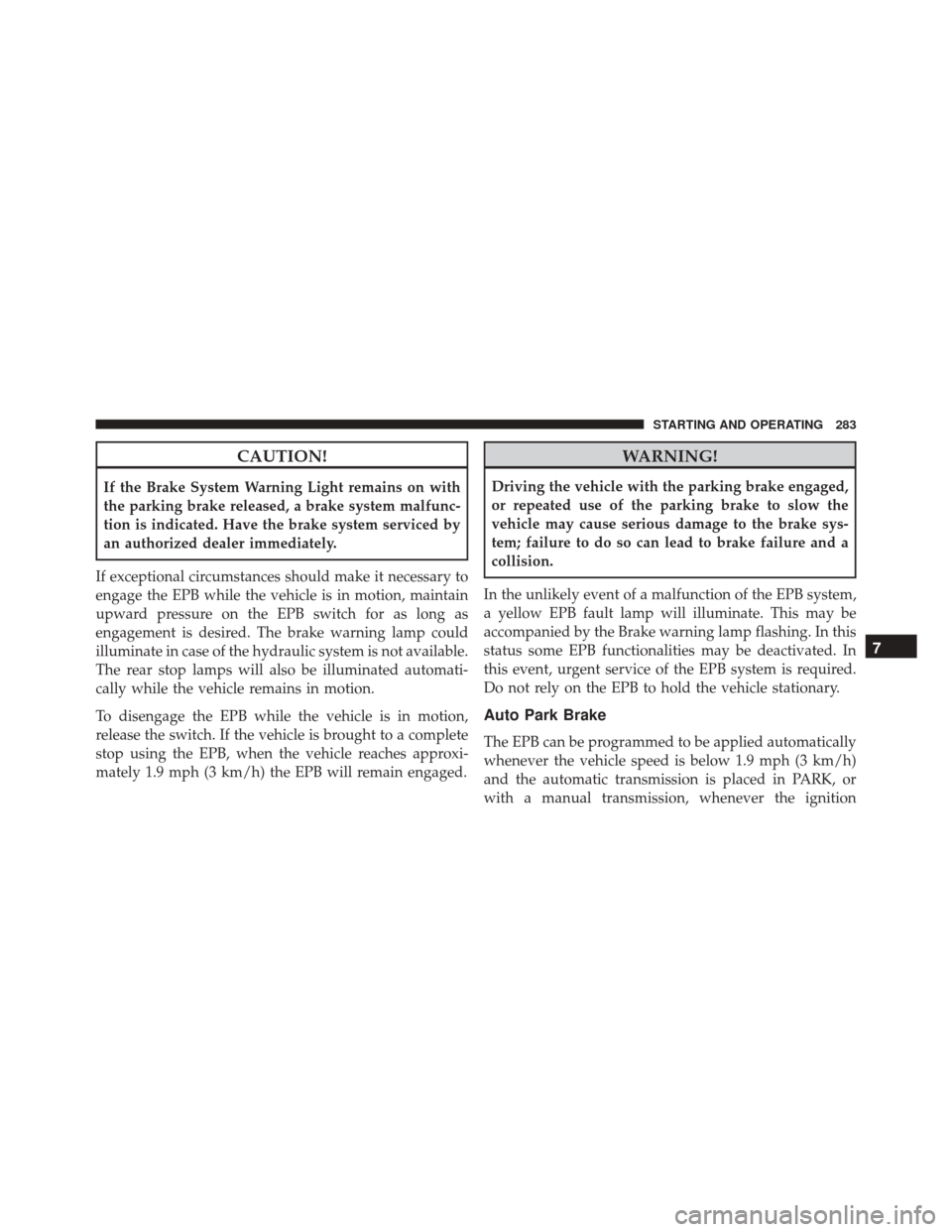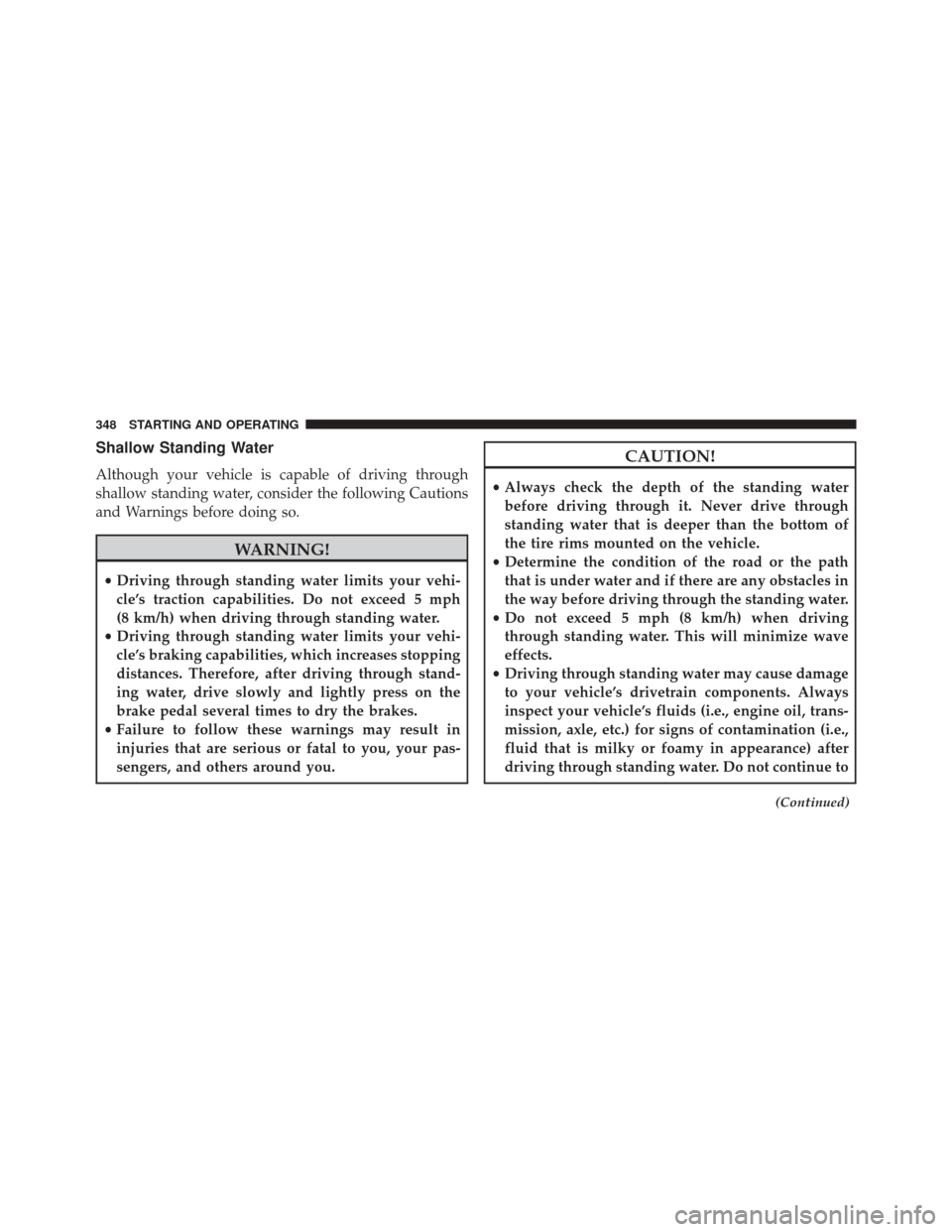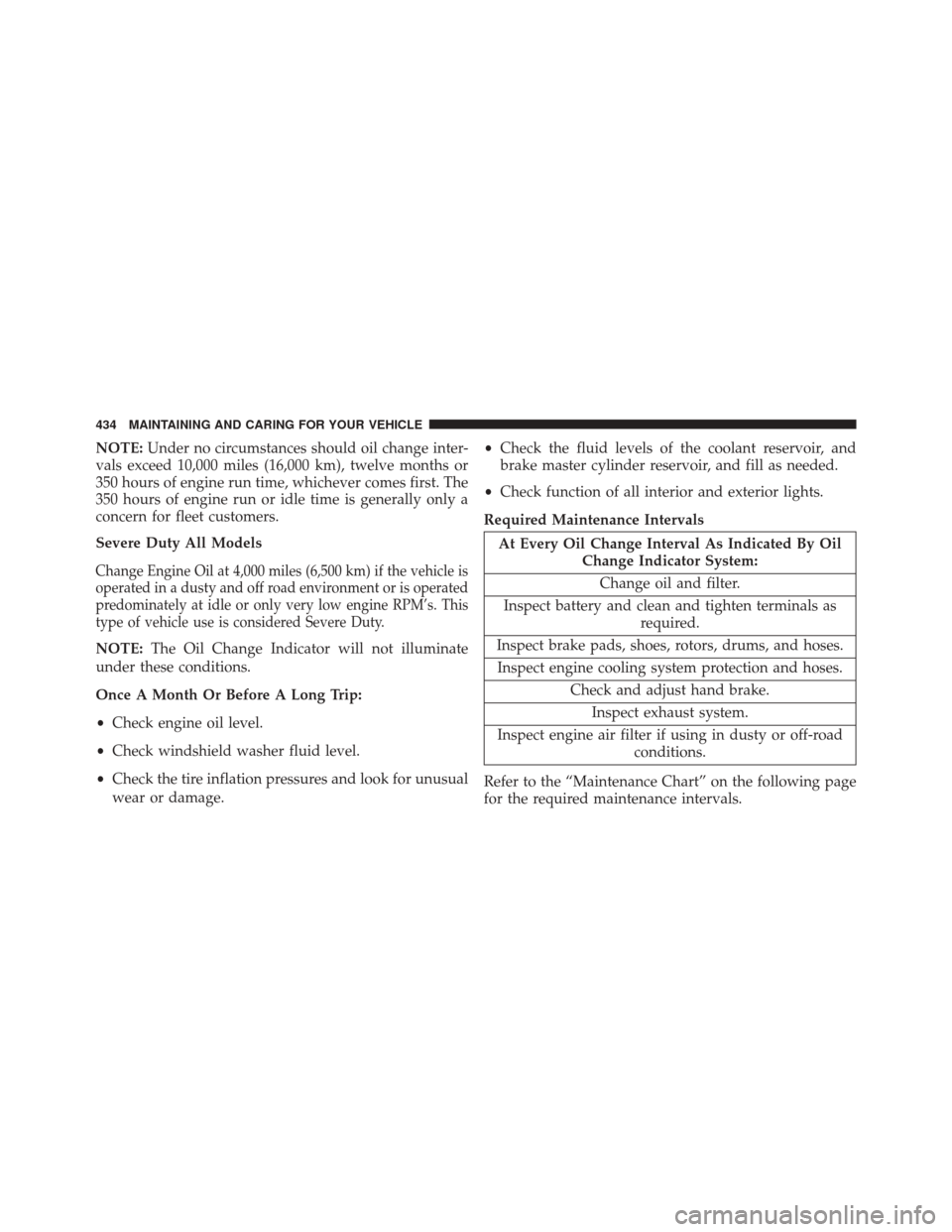Page 282 of 587

To apply the EPB manually, pull up on the switch
momentarily. You may hear a slight whirring sound from
the back of the vehicle while the EPB engages. Once the
parking brake is fully engaged, the BRAKE warning
lamp in the instrument cluster and an indicator on the
switch will illuminate. If your foot is on the brake pedalwhile you apply the EPB, you may notice a small amount
of brake pedal movement. The EPB can be applied even
when the ignition switch is in the STOP/OFF position
but the BRAKE warning lamp will not illuminate, how-
ever, it can only be released when the ignition switch is in
the MAR/RUN position.
NOTE:
The EPB fault lamp will illuminate if the EPB
switch is held for longer than 20 seconds in either the
released or applied position. The light will extinguish
upon releasing the switch.
If the Auto Park Brake feature is enabled, the EPB will
automatically engage whenever the transmission is
placed into PARK, or with a manual transmission, when
the ignition switch is in the STOP/OFF position. If your
foot is on the brake pedal, you may notice a small amount
of brake pedal movement while the EPB is engaging.
Electric Park Brake Switch
280 STARTING AND OPERATING
Page 283 of 587

The EPB will be automatically released if the driver ’s seat
belt is buckled and driver’s intention to start (in forward
or reverse direction) is recognized by the system
To release the EPB manually, the ignition switch must be
in the MAR/RUN position. Put your foot on the brake
pedal, then push the EPB switch down momentarily. You
may hear a slight whirring sound from the back of the
vehicle while the parking brake disengages. You may
also notice a small amount of movement in the brake
pedal. Once the EPB is fully disengaged, The BRAKE
warning lamp in the instrument cluster and the LED
indicator on the switch will extinguish.NOTE:
•
When parking on a hill, it is important to turn the front
wheels toward the curb on a downhill grade and away
from the curb on an uphill grade. Apply the EPB
before placing the shift lever in PARK, otherwise the
load on the transmission locking mechanism may
make it difficult to move the shift lever out of PARK.
The EPB should always be applied whenever the
driver is not in the vehicle.
• If the clutch pedal is released at the same time the gas
pedal is pressed, the EPB will be automatically re-
leased (manual transmissions only).
WARNING!
• Never use the PARK position as a substitute for the
parking brake. Always apply the parking brake
(Continued)
7
STARTING AND OPERATING 281
Page 285 of 587

CAUTION!
If the Brake System Warning Light remains on with
the parking brake released, a brake system malfunc-
tion is indicated. Have the brake system serviced by
an authorized dealer immediately.
If exceptional circumstances should make it necessary to
engage the EPB while the vehicle is in motion, maintain
upward pressure on the EPB switch for as long as
engagement is desired. The brake warning lamp could
illuminate in case of the hydraulic system is not available.
The rear stop lamps will also be illuminated automati-
cally while the vehicle remains in motion.
To disengage the EPB while the vehicle is in motion,
release the switch. If the vehicle is brought to a complete
stop using the EPB, when the vehicle reaches approxi-
mately 1.9 mph (3 km/h) the EPB will remain engaged.
WARNING!
Driving the vehicle with the parking brake engaged,
or repeated use of the parking brake to slow the
vehicle may cause serious damage to the brake sys-
tem; failure to do so can lead to brake failure and a
collision.
In the unlikely event of a malfunction of the EPB system,
a yellow EPB fault lamp will illuminate. This may be
accompanied by the Brake warning lamp flashing. In this
status some EPB functionalities may be deactivated. In
this event, urgent service of the EPB system is required.
Do not rely on the EPB to hold the vehicle stationary.
Auto Park Brake
The EPB can be programmed to be applied automatically
whenever the vehicle speed is below 1.9 mph (3 km/h)
and the automatic transmission is placed in PARK, or
with a manual transmission, whenever the ignition
7
STARTING AND OPERATING 283
Page 309 of 587

All Weather Mode –This mode offers increased traction
control and stability control for low traction conditions
such as driving in snow or rain.
Sport Mode – This mode is designed to increase steering
feedback to the driver with a slight increase in effort and
changes the transmission shift schedules for more aggres-
sive shifting. This driving mode is useful while driving
on twisty roads where more steering precision is desired
in spirited cornering.
Warning Messages
In the event of a system fault, the system automatically
defaults to �Auto�mode and a message will appear in the
EVIC display.
Refer to “Electronic Vehicle Information Center (EVIC)”
in “Getting To Know Your Instrument Cluster” for fur-
ther information.
BRAKE CONTROL — IF EQUIPPED
Brake Control
The Brake Control system with mitigation provides the
driver with audible warnings, visual warnings (within
the EVIC), and may apply a brake jerk to warn the driver
when it detects a potential frontal collision. The warnings
and limited braking are intended to provide the driver
with enough time to react, avoid or mitigate the potential
collision.
NOTE:
• Brake Control monitors the information from the for-
ward looking sensors as well as the Electronic Brake
Controller (EBC), to calculate the probability of a
forward collision. When the system determines that a
forward collision is probable, the driver will be pro-
vided with audible and visual warnings and may
provide a brake jerk warning.
7
STARTING AND OPERATING 307
Page 350 of 587

Shallow Standing Water
Although your vehicle is capable of driving through
shallow standing water, consider the following Cautions
and Warnings before doing so.
WARNING!
•Driving through standing water limits your vehi-
cle’s traction capabilities. Do not exceed 5 mph
(8 km/h) when driving through standing water.
• Driving through standing water limits your vehi-
cle’s braking capabilities, which increases stopping
distances. Therefore, after driving through stand-
ing water, drive slowly and lightly press on the
brake pedal several times to dry the brakes.
• Failure to follow these warnings may result in
injuries that are serious or fatal to you, your pas-
sengers, and others around you.
CAUTION!
• Always check the depth of the standing water
before driving through it. Never drive through
standing water that is deeper than the bottom of
the tire rims mounted on the vehicle.
• Determine the condition of the road or the path
that is under water and if there are any obstacles in
the way before driving through the standing water.
• Do not exceed 5 mph (8 km/h) when driving
through standing water. This will minimize wave
effects.
• Driving through standing water may cause damage
to your vehicle’s drivetrain components. Always
inspect your vehicle’s fluids (i.e., engine oil, trans-
mission, axle, etc.) for signs of contamination (i.e.,
fluid that is milky or foamy in appearance) after
driving through standing water. Do not continue to
(Continued)
348 STARTING AND OPERATING
Page 361 of 587
Exterior Bulbs
LampsBulb Number
Low Beam/High Beam Headlamps HIR2
Front Position/Daytime Running Lights (DRL ) P21/5
Front Direction Indicator Lamps PY21W
Front Fog Lamps H8
Side Indicators (Side View Mirror) WY5W
Tail/Brake Lights/Turn Indicators P21W
Center High Mounted Stop Lamp (CHMSL) LED (Serviced at an Authorized Dealer)
Reverse P21W
License Plate Lamp W5W
8
IN CASE OF EMERGENCY 359
Page 389 of 587
Cavity Mini FuseDescription
F31 7.5 Amp Brown Fan Air Conditioning, Power Socket
F33 20 Amp Yellow Power Window Front (Passenger Side)
F34 20 Amp Yellow Power Window Front (Drivers Side)
F36 15 Amp Blue Supply Uconnect System, Air Conditioning, USB Port, Rear lateral ceiling light in case of open roof, EOBD port
F37 10 Amp Red System Power Forward Collision Warning Plus, All Wheel Drive (AWD), IPC, Central stack switches, Brake Pedal Switch (NC)
F38 20 Amp Yellow Central Locking
F42 7.5 Amp Brown BSM - Brake Control Module, EPS - Electric Power-Assisted Steering
F43 20 Amp Yellow Bi-directional Pump Washer
F47 20 Amp Yellow Power Rear Window (Driver Side)
F48 20 Amp Yellow Power Rear Window (Passenger Side)
F49 7.5 Amp Brown Supply ParkSense, Spot Lights Front Dome, Internal Electocromic Mirror, Heated Front Seats
F50 7.5 Amp Brown Supply Air Bag
8
IN CASE OF EMERGENCY 387
Page 436 of 587

NOTE:Under no circumstances should oil change inter-
vals exceed 10,000 miles (16,000 km), twelve months or
350 hours of engine run time, whichever comes first. The
350 hours of engine run or idle time is generally only a
concern for fleet customers.
Severe Duty All Models
Change Engine Oil at 4,000 miles (6,500 km) if the vehicle is
operated in a dusty and off road environment or is operated
predominately at idle or only very low engine RPM’s. This
type of vehicle use is considered Severe Duty.
NOTE: The Oil Change Indicator will not illuminate
under these conditions.
Once A Month Or Before A Long Trip:
• Check engine oil level.
• Check windshield washer fluid level.
• Check the tire inflation pressures and look for unusual
wear or damage. •
Check the fluid levels of the coolant reservoir, and
brake master cylinder reservoir, and fill as needed.
• Check function of all interior and exterior lights.
Required Maintenance Intervals
At Every Oil Change Interval As Indicated By Oil Change Indicator System:
Change oil and filter.
Inspect battery and clean and tighten terminals as required.
Inspect brake pads, shoes, rotors, drums, and hoses. Inspect engine cooling system protection and hoses. Check and adjust hand brake.Inspect exhaust system.
Inspect engine air filter if using in dusty or off-road conditions.
Refer to the “Maintenance Chart” on the following page
for the required maintenance intervals.
434 MAINTAINING AND CARING FOR YOUR VEHICLE